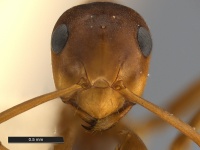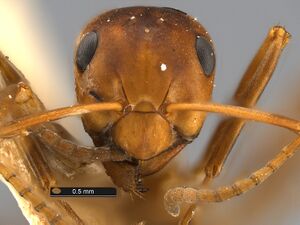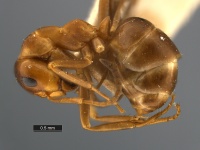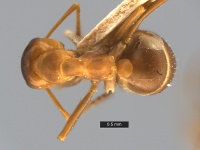Formica morsei
| Formica morsei | |
|---|---|

| |
| Scientific classification | |
| Kingdom: | Animalia |
| Phylum: | Arthropoda |
| Class: | Insecta |
| Order: | Hymenoptera |
| Family: | Formicidae |
| Subfamily: | Formicinae |
| Tribe: | Formicini |
| Genus: | Formica |
| Species group: | microgyna |
| Species: | F. morsei |
| Binomial name | |
| Formica morsei Wheeler, W.M., 1906 | |
Little is known concerning the biology of this species. It was originally collected in a deciduous forest near Boston, Massachusetts, but unfortunately the type locality has been converted to a shopping mall (S. Cover, pers. comm.). It is known from limited material including a few workers from the Adirondack Mountains, New York (collected by Gary Alpert).
| At a Glance | • Temporary parasite |
Identification
The head of the worker of this species is wider than long, and rounded posteriorly. There only a few erect hairs scattered on the dorsum of the head, on the ventral surface of the head, on the dorsum of the mesosoma, and on the gaster. Many hairs are blunt-tipped, but are not spatulate. The entire ant is a yellowish brown color.
It is difficult to relate this ant to other species and it is probably a member of the microgyna group which both Wheeler (1906, 1913) and Creighton (1950) supported. It would not be likely to confuse this species with any others, based on the shape of the head, and color.
Keys including this Species
Distribution
Latitudinal Distribution Pattern
Latitudinal Range: 42.28343° to 42.28343°.
| North Temperate |
North Subtropical |
Tropical | South Subtropical |
South Temperate |
- Source: AntMaps
Distribution based on Regional Taxon Lists
Nearctic Region: United States (type locality).
Distribution based on AntMaps
Distribution based on AntWeb specimens
Check data from AntWeb
Countries Occupied
| Number of countries occupied by this species based on AntWiki Regional Taxon Lists. In general, fewer countries occupied indicates a narrower range, while more countries indicates a more widespread species. |

|
Estimated Abundance
| Relative abundance based on number of AntMaps records per species (this species within the purple bar). Fewer records (to the left) indicates a less abundant/encountered species while more records (to the right) indicates more abundant/encountered species. |

|
Biology
This species is likely to be a temporary parasite of another species of Formica, but its host is unknown.
Castes
Worker

| |
| . | |
Images from AntWeb
   
| |
| Cotype of Formica morsei. Worker. Specimen code casent0103381. Photographer April Nobile, uploaded by California Academy of Sciences. | Owned by USNM, Washington, DC, USA. |
Nomenclature
The following information is derived from Barry Bolton's Online Catalogue of the Ants of the World.
- morsei. Formica morsei Wheeler, W.M. 1906a: 39, pl. 4, fig. 1 (w.) U.S.A.
- Status as species: Wheeler, W.M. 1906b: 19; Wheeler, W.M. 1913f: 480 (redescription); Creighton, 1950a: 504; Smith, D.R. 1979: 1462; Bolton, 1995b: 199; Ellison, et al. 2012: 162.
Type Material
- Syntype, 3 workers, South Natick, Massachusetts, United States, 42°16′N 71°19′W / 42.27°N 71.32°W, 9-13 September (year not given), A.P. Morse, Museum of Comparative Zoology.
- Syntype, 3 workers, South Natick, Massachusetts, United States, 42°16′N 71°19′W / 42.27°N 71.32°W, A.P. Morse, National Museum of Natural History.
Description
References
- Wheeler, W. M. 1906. New ants from New England. Psyche (Camb.) 13: 38-41 (page 39, pl. 4, fig. 1 worker described)
- Wheeler, W. M. 1913. A revision of the ants of the genus Formica (Linné) Mayr. Bulletin of the Museum of Comparative Zoology 53: 379-565 (page 480, see also)
References based on Global Ant Biodiversity Informatics
- Wheeler W. M. 1906. New ants from New England. Psyche (Cambridge) 13: 38-41

